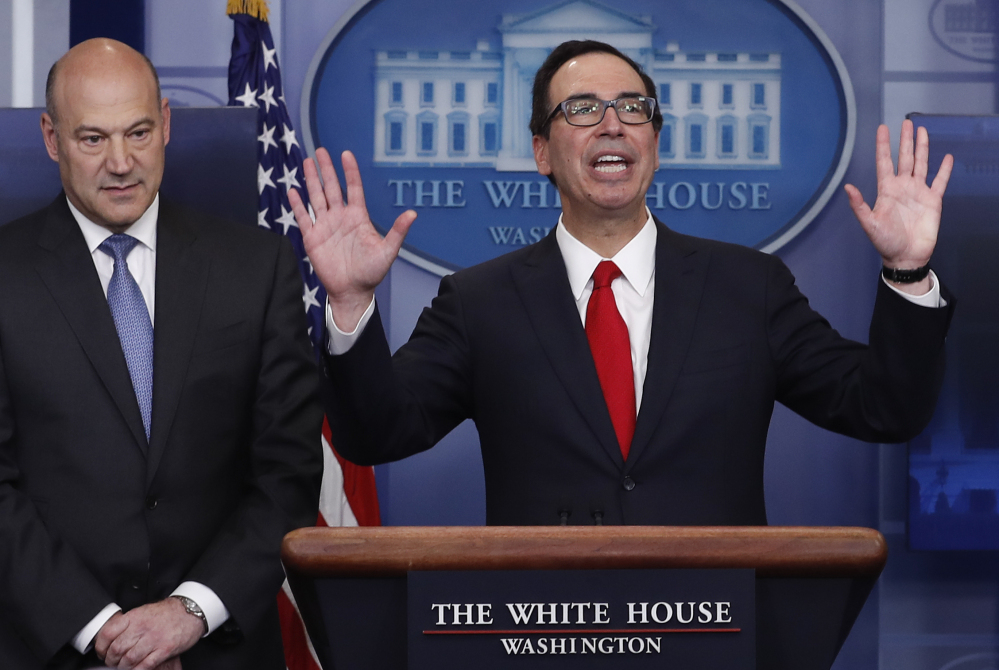At the center of President Trump’s plan to dramatically cut taxes on businesses and individuals is a promise to stimulate extraordinary economic growth, so much so, his advisers say, that the plan will pay for itself.
If he succeeds in keeping that promise, Trump will have accomplished something that his tax-cutting Republican predecessors failed to do, according to economists and tax policy experts from both parties.
In describing the proposal Wednesday, Trump’s top economic advisers said the plan would unleash new investment and spending by American companies and consumers, supercharging economic growth. That growth, in turn, would prevent the plan from leaving the federal government short trillions of dollars of tax revenue.
But in the experience of two other Republican presidents, Ronald Reagan and George W. Bush, tax cuts produced an uneven record on prompting economic growth. And in both instances, reductions in taxes failed to pay for themselves and instead left the nation to deal with increasing federal debt.
After his 1981 tax cut, Reagan was forced to raise taxes several times. And Bush’s tax cuts put the nation on vulnerable fiscal footing, depriving the government of revenue as the United States waged two wars and faced a financial crisis. Ultimately, Congress and President Barack Obama, after several standoffs over federal finances, increased taxes by billions of dollars and imposed strict limits on government spending.
Economists fear it will happen again. “This is definitely not in pays-for-itself territory,” Alan Cole, an economist at the conservative Tax Foundation, said.
Treasury Secretary Steven Mnuchin said the plan would curb the debt. “The economic plan under Trump will grow the economy and will create massive amounts of revenues, trillions of dollars in additional revenues,” Mnuchin said.
Trump’s tax guidelines diverge from an effort by congressional Republicans, led by House Speaker Paul Ryan, to craft a plan that aims to cut rates while keeping the government’s total tax revenue level, as the reductions would be balanced out by new taxes elsewhere and the elimination of loopholes.
For Trump, the attraction of his strategy is that it allows his administration to avoid proposing massive spending cuts or offsetting tax increases to keep the debt in check. And indeed, even the modest proposals he is making to raise some offsetting funding – such as limiting tax deductions to offset state and local taxes – promise to be controversial as he attempts to enlist Congress in support of his plans.
But while Trump says his tax plan is part of a broader agenda that will validate his campaign promises of economic growth not seen for decades, economists remain skeptical.
After reviewing the tax policy outline that the Trump administration released, several said they are hopeful that Republicans can craft a plan that would have modest benefits for the economy, but few expected Trump to be able to deliver the level of growth he has promised.
“The evidence shows clearly that no feasible tax reform in this country will raise economic growth to 3 percent on a sustained basis, given our current demographics,” said Doug Elmendorf, former director of the Congressional Budget Office.
As Trump attempts to succeed where Reagan stumbled, he will deal with multiple hurdles the former president didn’t, argued Douglas Holtz-Eakin, a former adviser in the Bush White House.
When Reagan reduced rates, he cut the maximum marginal rate on ordinary income for individual taxpayers from 70 percent to 50 percent. That rate currently sits at 39.6 percent, and cutting it further is unlikely to have the same on-the-ground impact on taxpayers’ decisions.
“Further reductions in rates are “just not going to have as big an impact as some of those early, dramatic fixes did,” Holtz-Eakin said.
Trump is also coming into office with facing far more debt. According to the Congressional Budget Office, the U.S. public debt is the equivalent of 77 percent of gross domestic product, a level that’s more than double the rate faced by Bush or Reagan.
“I don’t want to run some fiscal-policy experiment with the largest, most important economy on the planet. I mean, we’re not Belgium,” said James Pethokoukis, an economic commentator at the conservative American Enterprise Institute. “I would urge caution.”
Trump will be attempting to cut taxes in a more difficult environment than either Bush or Reagan, but even those two presidents’ policies had mixed results. Economists debate how successful they were in stimulating the economy, but nearly all agree that the cuts ultimately added to the debt, as they failed to pay for themselves.
During the Bush administration, two rounds of large-scale tax cuts, first in 2001 and then in 2003, were followed by an economy that stagnated and then cratered amid the financial crisis of 2008. The economy grew at an average rate of 2.1 percent annually during his eight years in office, though there were external factors – including 9/11 and the economic aftershock.
Reagan experienced far more economic success. When he cut rates in 1981, the economy was beginning to recover from a tumultuous decade of unemployment and inflation. By 1984, however, the GDP expanded at an annual rate of 7.3 percent in 1984, an extraordinary figure. The expansion continued for the remainder of Reagan’s term, but in no year since 1984 has GDP growth reached even 5 percent annually.
Send questions/comments to the editors.



Success. Please wait for the page to reload. If the page does not reload within 5 seconds, please refresh the page.
Enter your email and password to access comments.
Hi, to comment on stories you must . This profile is in addition to your subscription and website login.
Already have a commenting profile? .
Invalid username/password.
Please check your email to confirm and complete your registration.
Only subscribers are eligible to post comments. Please subscribe or login first for digital access. Here’s why.
Use the form below to reset your password. When you've submitted your account email, we will send an email with a reset code.